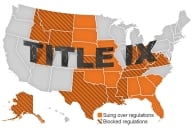You have /5 articles left.
Sign up for a free account or log in.
Higher education is hardly dominating the political airwaves this election season, but a number of ballot initiatives across the country could significantly impact colleges and universities.
Dan Hurley, director of State Relations and Policy Analysis for the American Association of State Colleges and Universities sees the ballot measures as falling into four buckets: revenue impacts, college access, capital improvements, and autonomy.
The most contentious and discussed revenue measure is California’s Prop 30, a tax increase that would provide badly needed money for the University of California, California State University, and California Community College systems. Prop 30 is one of two proposed education taxes on the California ballot, though the other, Proposition 38, relates exclusively to K-12 and early education. If voters fail to pass Prop 30, California colleges and universities would have to contend with massive budget cuts.
In the realm of college access, the most widely watched measure is Maryland’s DREAM Act referendum, which would allow undocumented students to pay in-state tuition at Maryland community colleges and universities provided they meet a strict set of requirements. Though it’s not the most widely talked-about ballot question in Maryland this fall, with the state also voting on gay marriage, Hurley says the result could reverberate across the country – particularly if the DREAM Act is voted down.
Elsewhere, Washington State is voting on an autonomy measure, and several states, most notably New Jersey, are voting on bond issues.
Over all, Hurley acknowledges, “It seems to be a bit of a thinner field.” Still, the limited number of measures could have important effects, both short-term and long-term.
Here is a round-up of some of the significant ballot measures voters will address in November:
Maryland
For the first time, a statewide DREAM Act is on the ballot.
Maryland’s legislature passed a state DREAM Act earlier this year, but opponents quickly gathered signatures to bring the issue to referendum, and now voters will decide whether or not undocumented students are eligible for in-state tuition at Maryland community colleges and universities.
“If this passes, in that the DREAM Act is not allowed to stay in legislation, I do think this is an issue that is going to have a potential domino effect,” Hurley said.
Maryland’s in-state tuition bill, as it is also called, applies stringent criteria for undocumented students to in-state aid. To be eligible, a student must attend a Maryland high school for at least three years, graduate from a Maryland high school, and provide proof that his family has filed a Maryland income tax return for at least three years. At that point, the student is qualified for the in-state rate only at community colleges; a student must complete at least 60 units at a community college before becoming eligible for resident tuition rates at Maryland’s four-year universities.
“Maryland has gone about it in the most moderate method that would appease those with concerns,” Hurley said.
Still, Kristin Ford, communications director for Educating Maryland Kids, a coalition of organizations that support the DREAM Act, said supporters are fighting a battle of misinformation.
“It isn’t special treatment and it isn’t a scholarship program…which is a misconception that we often have to clear up,” Ford said.
Roberto Juarez, a campaign coordinator with the United Dream Network, said he has talked to a handful of voters who are simply anti-immigrant, but most others support the in-state tuition bill once they understand it.
“In general, folks really don’t have any idea about it,” Juarez said. “It has just been a lot of education, explaining the facts, and answering questions or concerns.”
Part of the reason voters might not be up to speed on the Maryland DREAM Act is that other Maryland propositions, specifically related to same-sex marriage and to gambling, have been getting a great deal of attention in Maryland. That might be because the DREAM Act, unlike the other ballot measures, does not actually have registered ballot committees on both sides of the issue; although the website Help Save Maryland has run some anti-DREAM Act ads, there is no true opposition campaign.
Recent polls have yielded good news for DREAM Act supporters. A Baltimore Sun poll found that 44 percent of voters support the in-state tuition bill, while 41 percent oppose it. A poll by Gonzales Research generated even more decisive results, with 58 percent of voters saying they will vote for the DREAM act, and 34 percent saying they will vote against it.
If the in-state tuition bill passes, it is expected to impact about 435 students in each entering freshman class, according to an analysis by the Maryland Institute for Policy Analysis & Research. The report also predicts a positive economic impact to the state.
If it doesn’t pass, however, Hurley predicts Dream Act opponents in states that do offer in-state tuition to undocumented students may follow suit and try to bring the issue to a referendum vote.
“If it passes it’s going to raise the eyebrows of a lot of other…people that are not supportive of those policies in those states that off them,” he said.
Michigan
Michigan’s Prop 5 is not explicitly related to higher ed, but it could have serious ramifications.
The proposal would require a two-thirds majority of the State House or State Senate to impose any new taxes or to increase the tax rate.
A number of states already require a supermajority to reform taxes, and the policy often becomes “a stranglehold,” Hurley said, pointing to California as a prime example.
Voters seem to favor the proposal, though support is falling.
David Waymire, a spokesman for the Vote No on Prop 5 campaign, said opponents of the measure have been focusing on the negative impact it could have on the state to essentially freeze the current tax system.
“It sets us up so you’re into a spiral of continually lowering your investment into your state’s public goods,” Waymire said.
Waymire also notes that Michigan has cut state support for higher education by about 30 percent in the past decade, and that making it harder to fund education could be disastrous.
“Higher ed is the single most important key to prosperity and we will be unable to invest in higher ed,” he said.
If the proposal passes, Waymire worries the state universities won’t be able to graduate as many students, which would have a negative impact on the state economy and make it difficult to attract young people the state.
“When we talk to people, we say, ‘it means your kids and grandkids will leave the state and will not come back,’” he said. “That’s exactly what you see in these poor states where they are losing talent at alarming rates. Most people would like to have their children stay in-state.”
Michigan colleges and universities recognize the threat Prop 5 poses, and a number of student newspapers have gotten involved in the campaign against the proposal, along with some faculty and staff.
“It puts public university presidents in a tough bind,” Hurley said. “They know the ramifications are negative but they may have an eight-member board they report to that consists of majority of fiscal conservatives.”
Michigan graduate students, meanwhile, are paying close attention to Proposal 2, which would grant employees that right to organize and bargain collectively and could invalidate existing laws, such as the one passed earlier this year prohibiting graduate student research assistants from organizing.
“Collective bargaining allows us to have a say in our working conditions,” said Elizabeth Rodrigues, communications co-chair for the Graduate Employees’ Organization, a labor union representing about 1,800 graduate student instructors and staff assistants at the University of Michigan. “It helps us map out our careers…so we can balance our workload, and it helps us fight for fair wages and benefits.”
GEO has been organizing rallies and reaching out to voters in support of Prop 2, but otherwise, higher ed has remained relatively uninvolved, according to Michael Boulus, executive director of the Presidents Council of the State Universities of Michigan.
“The one higher ed is most engaged in is Proposal 5,” Boulus said. “That’s the one that gives us heartburn.”
New Jersey
For the first time since 1988, New Jersey colleges and universities could win authority to have general obligation bonds issued on their behalf. If voters pass Public Question 1, the state will issue $750 million to public and private institutions, divvying out $300 million on behalf of public research universities, $247.5 million to state colleges and other state universities, $150 million for county colleges, and $52.5 million to private colleges and universities with endowments of less than $1 billion.
“Having a general obligation bond of this magnitude really shows the commitment of the state toward public higher ed, and it gives the institutions a chance to get some desperately needed capital funds for new facilities,” said Michael Klein, executive director of the New Jersey Association of State Colleges & Universities.
It is atypical, Hurley noted, for bond measures to include funding for private universities, but Klein said because the independent sector is an important part of higher education in New Jersey, and because independent colleges would receive the smallest share of the funds, it seemed “appropriate” that they be included.
A recent poll shows most voters don’t know much about the issue, but 48 percent still say they support it, while 34 percent of voters oppose the bond measure.
One of the major selling points, Klein said, is that the funds are specifically for new facilities.
“That’s something we’re playing up to the electorate is that they can go into the ballot box and support the building of labs and classrooms,” Klein said.
Students have also been working to generate support for the issue, and campus voter registration drives have been combined with advocacy efforts on the bond issue. Many college and university leaders are speaking up, too, emphasizing the benefits of higher education for the state.
“There is no doubt the institutions need the money,” Hurley said.
Washington State
Falling under the umbrella Hurley calls “autonomy,” Washington residents will vote on whether or not the University of Washington and Washington State University can invest public money in the stocks and bonds of private companies, associations, and corporations. Currently, permanent higher education funds can be invested in private stocks and bonds, but public funds cannot.
It’s not uncommon for universities to seek new sources of revenue when budgets are tight, Hurley said, and recently lawmakers have been more willing to explore new avenues, like investing in private stocks.
There are already a number of other state entities in Washington that have been granted exemptions to invest in private stocks and bonds. If the measure passes, the legislature would still dictate how the funds are invested.
Arizona:
Arizona’s Quality Education & Jobs Act would extend a 1-cent sales tax that is set to expire at the end of this year. The funds would be used almost exclusively for education, and though more than half of the money is designated for K-12 education, some of the revenue would go to community college and university merit- and need-based scholarships and university operations. If the sales tax is not continued, the state will need to cut $1 billion from its university and K-12 budgets.
Missouri
Proposition B in Missouri would create a Health and Education Trust fund using the proceeds from a tax on cigarettes and tobacco products. The Trust Fund would be split among K-12 schools, colleges, and universities, and is expected to generate $283-$423
Bond Initiatives
Maine: $11.3 million, with $7.8 million going to the University of Maine, $3 million for the Maine Community College System, and $500,000 for the Marine Maritime Academy.
New Mexico: $120 million for capital improvements to higher education.
Rhode Island: $50 million for renovation of the buildings at Rhode Island College.








